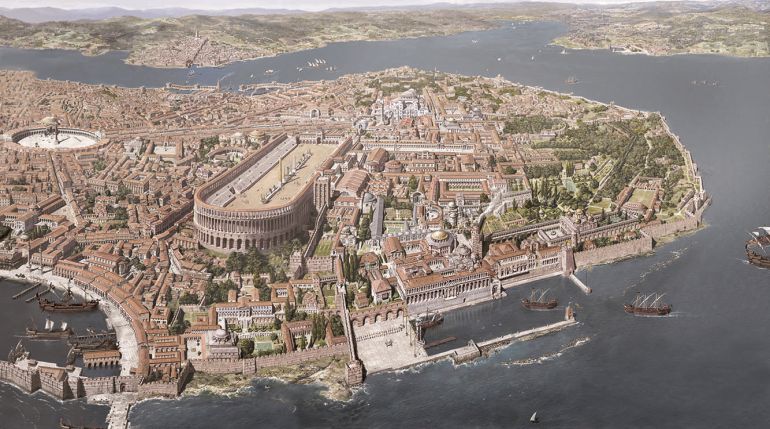Last month we peeled back the layers of history to expose the early life of that chap who is immortalised in bronze outside the Minster, Constantine the Great. Now, we pick up where we left off and look at his later years, in which he did war. Lots of war.
Tensions rising
So… there’s local lad Constantine, in York, having just declared himself Emperor of the Western Roman Empire. And there’s Galerius, Emperor of the Eastern Empire, a bit miffed at Constantine for having done so without approval. In fact, Constantine’s self-appointment caused massive unrest throughout the Empire, leading to clashes.
Constantine, meanwhile, stayed in York, seemingly happy to let all the trouble he had caused play out without his involvement. To keep himself busy he finished what he and his recently deceased father had started: pushing the Picts further into Scotland. What fun!
He also visited Gaul, modern day France, as that was technically his as well, and did yet more fighting against the Franks. During this time Constantine worked on his public image by returning to the Christians lands and goods that had previously been taken from them, and improving roads throughout Britain, France, and Spain. He was becoming increasingly popular.
Head of the pack
In the following years Constantine made uneasy peace with the other leaders of the Empire. However, an attempt on his life lead to the crumbling of the Tetrarchy; the system by which four men ruled. Maximium was killed for plotting the assassination, and in 311 CE Galerius died of an illness. This left Maxentius, the other ruler in the West, alone in Rome.
Using Maxentius’ unpopularity against him, Constantine marched his army into Italy, capturing city after city, until he reached Rome. Maxentius brought his army out to meet him, and the two sides famously met at The Milvian Bridge. Here’s where it starts to get weird.
According to legend, Constantine dreamt that the Christian God had urged him to paint the symbols of Chi Ro on his soldiers shields, the first two letters of ‘Christ’ in Greek. This he did, and his army triumphed against Maxentius, who was drowned in the Tiber river under the crush of his fleeing troops. Constantine pushed into Rome and was welcomed by the locals.
East is East
In 313 he met with Eastern ruler Licinius at Milan, to sign famous Edict of Milan. The treaty granted full toleration to the Christian faith, which was growing in popularity in the West. The two parted on relatively good terms, and the two halves of the Empire were at peace. For a bit. You see, in 320 Licinius decided to start mistreating Christians, and also (apparently) attempted to have Constantine assassinated.
What resulted was one of the biggest civil wars the Roman Empire had ever seen, with East versus West. Looking back, it was easy to see how Licinius represented the old pagan ways, especially considering he employed pagan Goth mercenaries; while Constantine represented the new ways, of Christianity.
After several huge battles, Constantine won and became the sole Emperor of a united Roman Empire. Licinius’ life was spared… right up until Constantine changed his mind and had him hanged. Oh, Constantine. You tease.
The New Rome
Now with the East under his control, he decided to build a new capital city. The Greek city of Byzantium was selected, as it had previously been rebuilt in the Roman fashion by another York Emperor, Septimius Severus (who is supposedly buried near Acomb). Constantinople was therefore founded in 324, which would later become modern day Istanbul.
Constantine then ruled to promote religious tolerance. Not only Christianity was legalised, but all other cults and sects. Basically, you could believe what you liked in Constantine’s Empire, and not suffer persecution.
By the age of 40 Constantine was openly referring to himself as Christian, but had decided not to be baptised until on his deathbed. He was also the guy who stated that Sunday had to be a day of rest for all citizens of the Empire. So it’s his fault B&Q is so busy on a Sunday morning.
He died of an illness in 337, after continuing to strengthen the united Roman Empire’s boarders. With the toleration and promotion of Christianity, Constantine changed the face of Europe, and the world.
In the century that followed his death, his Empire would start to crumble, starting with the withdrawal from where it all started for him; Britain. However, around the city that he founded in the East, the empire would continue, transforming into the Byzantine Empire.
There, it was an honour for rulers to be declared ‘The New Constantine’.









Add a comment